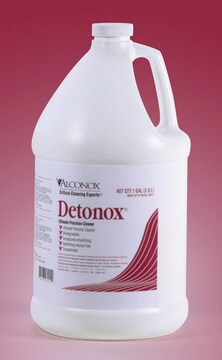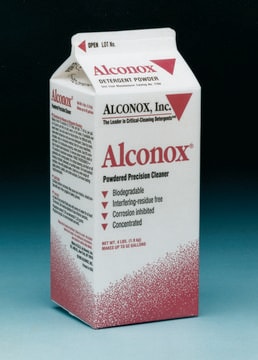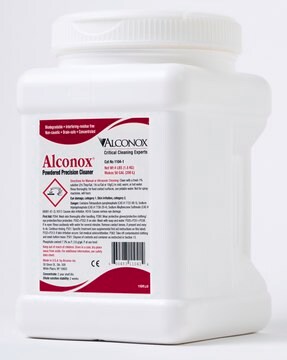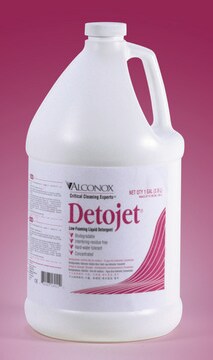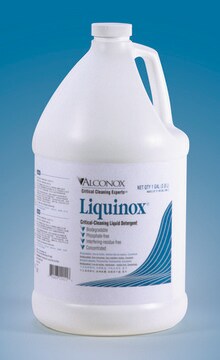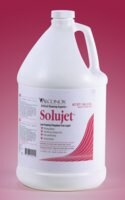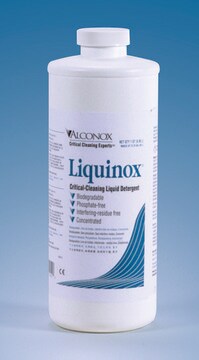Z742930
Keylajet® detergent, low foaming high alkaline liquid
pkg of 19 L
Synonym(s):
free rinsing cleaner, high alkaline liquid, tough-to-clean residue remover
Sign Into View Organizational & Contract Pricing
All Photos(1)
About This Item
UNSPSC Code:
47131800
Recommended Products
packaging
pkg of 19 L
manufacturer/tradename
Alconox, Inc.
application(s)
sample preservation
General description
Keylajet low-foaming chelating alkaline detergent
Used to clean: Manufacturing equipment, cosmetics residues, injection molds, fouled metal parts in maintenance and repair operations from marinas to automotive to aerospace to oil & gas, such as filters, fins, exchangers, pump heads, steel engine blocks, exhaust systems, and more; metal castings, forgings and stampings, industrial parts, pipes, tanks and reactors. Use to clean steel prior to passivation.
Used to remove: Hard to clean soils, grit, grime, slime, grease, buffing compounds, oils, particulates, deposits, chemical and solvents, mold releases, metal oxides, and much more.
Surfaces cleaned: Corrosion inhibited formulation recommended for hard metals, steels, stainless steel, porcelain, ceramic, rigid plastics, cement, and elastomers. Do not use on soft metals such as copper, aluminum, zinc and magnesium.
Cleaning method: Soak, spray, brush, sponge, cloth, ultrasonic, flow through clean-in-place, agitation, or automated washing. Please ensure gasket compatibility.
Directions: Make a fresh 1% solution (2 1/2 Tbsp. per gal., 1 1/4 oz. per gal. or 10 ml per liter) in warm or hot water. For difficult soils or to remove metal oxides, raise water temperature and use more detergent, up to 10% by volume. Clean by soak, circulate, wipe, spray, or ultrasonic method. RINSE THOROUGHLY—preferably with running water.
For critical cleaning, do final or all rinsing in distilled, deionized or purified water. For food contact surfaces, rinse with potable water. Corrosion testing may be advisable for high-carbon steels, and may require rust preventative application post-cleaning.
- Concentrated to save you money
- Corrosion inhibited formula
- Caustic liquid detergent with chelators
- Free rinsing to give you reliable results and no interfering residues
- For tough-to-clean residues on hard surfaces
Used to clean: Manufacturing equipment, cosmetics residues, injection molds, fouled metal parts in maintenance and repair operations from marinas to automotive to aerospace to oil & gas, such as filters, fins, exchangers, pump heads, steel engine blocks, exhaust systems, and more; metal castings, forgings and stampings, industrial parts, pipes, tanks and reactors. Use to clean steel prior to passivation.
Used to remove: Hard to clean soils, grit, grime, slime, grease, buffing compounds, oils, particulates, deposits, chemical and solvents, mold releases, metal oxides, and much more.
Surfaces cleaned: Corrosion inhibited formulation recommended for hard metals, steels, stainless steel, porcelain, ceramic, rigid plastics, cement, and elastomers. Do not use on soft metals such as copper, aluminum, zinc and magnesium.
Cleaning method: Soak, spray, brush, sponge, cloth, ultrasonic, flow through clean-in-place, agitation, or automated washing. Please ensure gasket compatibility.
Directions: Make a fresh 1% solution (2 1/2 Tbsp. per gal., 1 1/4 oz. per gal. or 10 ml per liter) in warm or hot water. For difficult soils or to remove metal oxides, raise water temperature and use more detergent, up to 10% by volume. Clean by soak, circulate, wipe, spray, or ultrasonic method. RINSE THOROUGHLY—preferably with running water.
For critical cleaning, do final or all rinsing in distilled, deionized or purified water. For food contact surfaces, rinse with potable water. Corrosion testing may be advisable for high-carbon steels, and may require rust preventative application post-cleaning.
Legal Information
Keylajet is a registered trademark of Alconox, Inc.
Signal Word
Danger
Hazard Statements
Precautionary Statements
Hazard Classifications
Acute Tox. 4 Oral - Eye Dam. 1 - Met. Corr. 1 - Skin Corr. 1A
Storage Class Code
8A - Combustible, corrosive hazardous materials
WGK
WGK 3
Certificates of Analysis (COA)
Search for Certificates of Analysis (COA) by entering the products Lot/Batch Number. Lot and Batch Numbers can be found on a product’s label following the words ‘Lot’ or ‘Batch’.
Already Own This Product?
Find documentation for the products that you have recently purchased in the Document Library.
Our team of scientists has experience in all areas of research including Life Science, Material Science, Chemical Synthesis, Chromatography, Analytical and many others.
Contact Technical Service